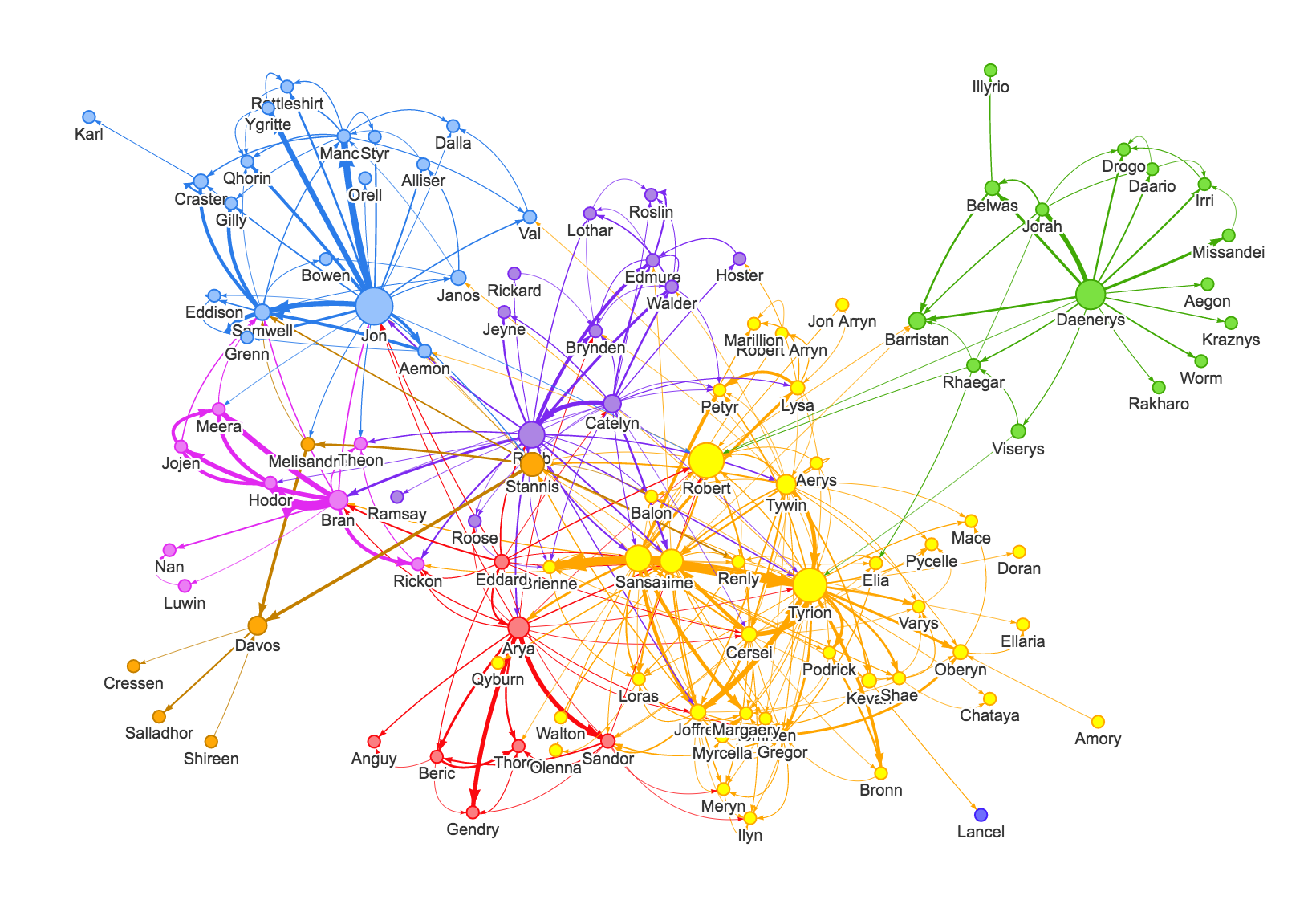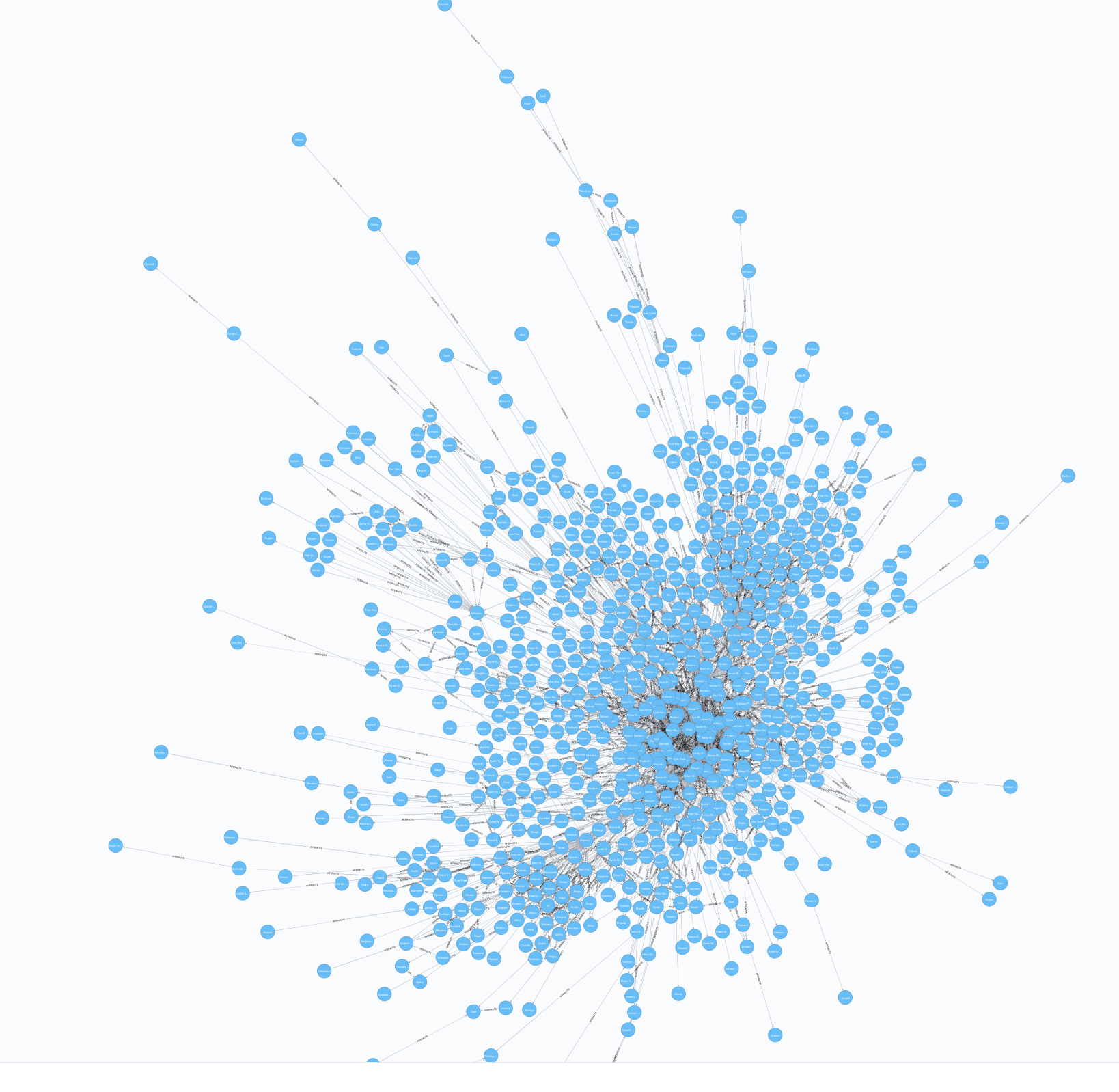neovis.js
Graph visualizations powered by vis.js with data from Neo4j.

Features
- Connect to Neo4j instance to get live data
- User specified labels and property to be displayed
- User specified Cypher query to populate
- Specify node property for url of image for node
- Specify edge property for edge thickness
- Specify node property for community / clustering
- Specify node property for node size
- Configure popover
Install
Neovis.js can be installed via npm:
npm install --save neovis.js
you can also obtain neovis.js via CDN:
CDN
For ease of use Neovis.js can be obtained from Neo4jLabs CDN:
Most recent release
<script src="https://cdn.neo4jlabs.com/neovis.js/v1.0.0/neovis.js"></script>
Master - warning, not stable
<script src="https://cdn.neo4jlabs.com/neovis.js/master/neovis.js"></script>
Quickstart Example
Let's go through the steps to reproduce this visualization:

Prepare Neo4j
Start with a blank Neo4j instance, or spin up a blank Neo4j Sandbox. We'll load the Game of Thrones dataset, run:
LOAD CSV WITH HEADERS FROM "https://raw.githubusercontent.com/mathbeveridge/asoiaf/master/data/asoiaf-all-edges.csv" AS row
MERGE (src:Character {name: row.Source})
MERGE (tgt:Character {name: row.Target})
MERGE (src)-[r:INTERACTS]->(tgt) ON CREATE SET r.weight = toInteger(row.weight)
We've pre-calculated PageRank and ran a community detection algorithm to assign community ids for each Character. Let's load those next:
LOAD CSV WITH HEADERS FROM "https://raw.githubusercontent.com/johnymontana/neovis.js/master/examples/data/got-centralities.csv" AS row
MATCH (c:Character {name: row.name})
SET c.community = toInteger(row.community),
c.pagerank = toFloat(row.pagerank)
Our graph now consists of Character nodes that are connected by an INTERACTS relationships. We can visualize the whole graph in Neo4j Browser by running:
MATCH p=(:Character)-[:INTERACTS]->(:Character)
RETURN p

We can see characters that are connected and with the help of the force directed layout we can begin to see clusters in the graph. However, we want to visualize the centralities (PageRank) and community detection results that we also imported.
Specifically we would like:
- Node size to be proportional to the Character's
pagerankscore. This will allow us to quickly identify important nodes in the network. - Node color to determined by the
communityproperty. This will allow us to visualize clusters. - Relationship thickeness should be proportional to the
weightproperty on theINTERACTSrelationship.
Neovis.js, by combining the JavaScript driver for Neo4j and the vis.js visualization library will allow us to build this visualization.
index.html
Create a new html file:
Neovis.js Simple Example
We define some basic CSS to specify the boundaries of a div and then create a single div in the body. We also specify onload="draw()" so that the draw() function is called as soon as the body is loaded.
We need to pull in neovis.js:
And define our draw() function:
<script type="text/javascript">
var viz;
function draw() {
var config = {
container_id: "viz",
server_url: "bolt://localhost:7687",
server_user: "neo4j",
server_password: "sorts-swims-burglaries",
labels: {
"Character": {
"caption": "name",
"size": "pagerank",
"community": "community"
}
},
relationships: {
"INTERACTS": {
"thickness": "weight",
"caption": false
}
},
initial_cypher: "MATCH (n)-[r:INTERACTS]->(m) RETURN *"
};
viz = new NeoVis.default(config);
viz.render();
}
</script>
This function creates a config object that specifies how to connect to Neo4j, what data to fetch, and how to configure the visualization.

See simple-example.html for the full code.
Build
This project uses git submodules to include the dependencies for neo4j-driver and vis.js. This project uses webpack to build a bundle that includes all project dependencies. webpack.config.js contains the configuration for webpack. After cloning the repo:
git submodule init
git submodule update
npm install
./node_modules/.bin/webpack
will build dist/neovis.js
Documentation
-
Neovis.default(config) -
Neovis.clearNetwork() -
Neovis.reinit(config) -
Neovis.reload() -
Neovis.stabilize() -
Neovis.renderWithCypher(statement) -
config
Neovis.default(config)
Constructor for Neovis. Creates new Neovis object, given configuration. See config
Neovis.clearNetwork()
Clears network visualization
Neovis.reinit(config)
Reinitializes the network visualization with a new config object. See config
Neovis.reload()
Reload the visualization. Will fetch data again from Neo4j per initial_cypher in the config object.
Neovis.stabilize()
Stop the physics simulation.
Neovis.renderWithCypher(statement)
Render a new visualization with results from a Cypher statement. Any Node and Relationship objects returned in the Cypher query will be rendered in the visualization. Paths are not currently supported.
config
A configuration object that defines:
- how to connect to Neo4j (required)
- an initial Cypher query for loading data for the visualization (optional)
- the DOM element in which the visualization should be rendered (required)
- how to style elements of the visualization (
labelsandrelationships) (required)
Example:
var config =container_id: "viz"server_url: "bolt://localhost:7687"server_user: "neo4j"server_password: "sorts-swims-burglaries"labels://"Character": "name","Character":"caption": "name""size": "pagerank""community": "community"//"sizeCypher": "MATCH (n) WHERE id(n) = {id} MATCH (n)-[r]-() RETURN sum(r.weight) AS c"relationships:"INTERACTS":"thickness": "weight""caption": falseinitial_cypher: "MATCH (n)-[r:INTERACTS]->(m) RETURN n,r,m";viz = config;viz;
config.container_id
config.server_url
config.server_user
config.server_password
config.labels
"Character": {
"caption": "name",
"size": "pagerank",
"community": "community",
sizeCypher: "MATCH (n) WHERE id(n) = {id} MATCH (n)-[r]-() RETURN sum(r.weight) AS c"
}
config.relationships
{
"INTERACTS": {
"thickness": "weight",
"caption": false
}
}
config.arrows
Boolean. Defaults to false.
config.hierarchical_layout
Boolean. Default to false.
config.hierarchical_sort_method
When hierarchical layout is enabled you may choose betweeen "hubsize" (default) and "directed".
config.initial_cypher
config.encrypted
"ENCRYPTION_OFF" (default) or "ENCRYPTION_ON"
config.trust
"TRUST_ALL_CERTIFICATES" (default) or "TRUST_SYSTEM_CA_SIGNED_CERTIFICATES"
